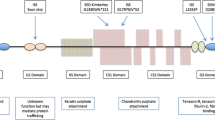Abstract
Achondrogenesis type IB (ACG-IB) is a recessively inherited chondrodysplasia characterized by extremely poor skeletal development and perinatal death1–6. A defect in sulphate metabolism leading to reduced sulphation of proteoglycans has been reported in one case7. The gene for diastrophic dysplasia (DID), a milder chondrodysplasia, was recently shown to encode a sulphate transporter (DTDST)8. We set out to test whether mutations in DTDST might be the cause of ACG-IB using cell cultures, cartilage samples and DMA from six patients. We found that ACGIB cartilage contains less sulphate than control cartilage, and that a sulphation defect is present in all ACG-IB cells and is caused by impaired sulphate uptake. Seven DTDST mutations accounting for all twelve chromosomes were identified in six ACG-IB patients. Thus, ACG-IB and DTD are allelic disorders. While DTD is associated with reduced DTDST expression, ACG-IB is produced by homozy-gosity or compound heterozygos-ity for structural mutations predicting little or no residual activity of the sulphate transporter and represents the null phenotype of DTDST.
Similar content being viewed by others
References
Fraccaro, M. Contribute allo studio del mesenchima osteopoietico— l'acondrogenesi. Folia Hereof. Path. 1, 190–213 (1952).
Spranger, J. et al. International Classification of Osteochondrodysplasias. Eur. J. Pediat. 151, 407–415 (1992).
Norton, W.A. & Hecht, J.T. The Chondrodysplasias. In Connective Tissue and its Heritable Disorders—Molecular, Genetics, and Medical Aspects (eds Royce, P.M. & Steinmann, B.) 641–675 (Wiley-Uss, New York 1993).
Rimoin, D.L. & Lachman, R.S. Genetic disorders of the osseous skeleton. In: Heritable Disorders of Connective Tissue, 5th ed (ed. Beighton, P.) 557–689 (Mosby-Year Book, St. Louis 1993).
Borochowitz, Z. et al. Achondrogenesis type I: delineation of further heterogeneity and identification of two distinct subgroups. J. Pediat. 112, 23–31 (1988).
van der Marten, H.J. et al. Achondrogenesis-Hypochondrogenesis: the spectrum of chondrogenesis imperfecta. Pediatr. Pathol. 8, 571–597 (1988).
Superti-Furga, A. A defect in the metabolic activation of sulfate in a patient with achondrogenesis type IB. Am. J. Hum. Genet. 55, 1137–1145 (1994).
Hastbacka, J. et al. The diastrophic dysplasia gene encodes a novel sulfate transporter positional cloning by fine-structure linkage disequilibrium mapping. Cell 78, 1073–1087 (1994).
Venn, M. & Maroudas, A. Chemical composition and swelling of normal and osteoarthnotic femoral cartilage I. Chemical composition. Ann. Rheum. Dis. 36, 121–129 (1977).
Urban, J.P.G., Hall, A.C. & Gehl, K.A. Regulation of matrix synthesis rates by theionic and osmotic environment of articular chondrocytes. J. Cell Physiol. 154, 262–270 (1993).
Esko, J.D., Elgavish, A., Prasthofer, T., Taylor, W.H. & Weinke, J.L. Sulfate transport-deficient mutants of Chinese hamster ovary cells—sulfation of glycosaminogylcans dependent on cysteine. J. Biol. Chem. 261, 15725–15733 (1986).
Bissig, M., Hagenbuch, B., Stieger, R., Koller, T. & Meier, R.J. Functional expression cloning of the canalicular sulfate transport system of rat hepatocytes. J. Biol. Chem. 269, 3017–3021 (1994).
Hästbacka, J. et al. Linkage disequilibrium mapping in isolated founder populations: diastrophic dysplasia in Finland. Nature Genet. 2, 204–211 (1992).
Spranger, J., Winterpacht, A. & Zabel, B. The type II collagenopathies: a spectrum of Chondrodysplasias. Eur. J. Pediatr. 153, 56–65 (1994).
Tavormina, P.L. Thanatophoric dysplasia (types I and II) caused by distinct mutations in fibroblast growth factor receptor 3. Nature Genet. 9, 321–328 (1995).
Bellus, G.A. et al. A recurrent mutation in the tyrosine kinase domain of fibroblast growth factor receptor 3 causes hypochondroplasia. Nature Genet. 10, 357–359 (1995).
Sharony, R., Browne, C., Lachman, R.S. & Rimoin, D.L. Prenatal diagnosis of the skeletal dysplasias. Am. J. Obstet Gynecol. 169, 668–675 (1993).
Budowle, B., Chakraborty, R., Giusti, A.M., Eisenberg, A.J. & Allen, R.C. Analysis of the VNTR Locus D1S80 by the PCR followed by high-resolution PAGE. Am. J. Hum. Genet. 48, 137–144 (1991).
Author information
Authors and Affiliations
Rights and permissions
About this article
Cite this article
Superti-Furga, A., Hästbacka, J., Wilcox, W. et al. Achondrogenesis type IB is caused by mutations in the diastrophic dysplasia sulphate transporter gene. Nat Genet 12, 100–102 (1996). https://doi.org/10.1038/ng0196-100
Received:
Accepted:
Issue Date:
DOI: https://doi.org/10.1038/ng0196-100
- Springer Nature America, Inc.
This article is cited by
-
A framework for the radiologic diagnosis of skeletal dysplasias and syndromes as revealed by molecular genetics
Pediatric Radiology (2019)
-
Dual novel mutations in SLC26A2 in two siblings with multiple epiphyseal dysplasia 4 from a Chinese family: a case report
BMC Medical Genetics (2018)
-
Biosynthesis of glycosaminoglycans: associated disorders and biochemical tests
Journal of Inherited Metabolic Disease (2016)





